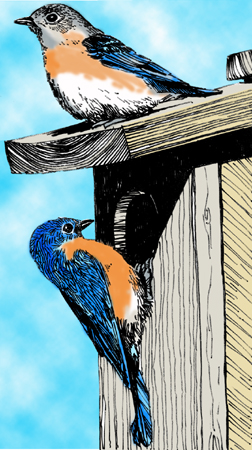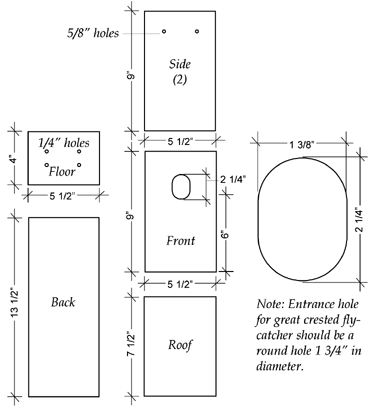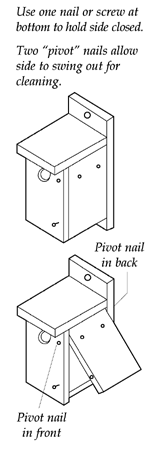Bulletin #7117, Birdhouse Basics
Bulletin #7117, Birdhouse Basics (PDF)
Prepared by Catherine A. Elliott, Extension wildlife specialist.
For information about UMaine Extension programs and resources, visit extension.umaine.edu.
Find more of our publications and books at extension.umaine.edu/publications/.

Birdhouses are an easy way to have more birds around your home or in your woodlot. In this fact sheet, we explain how to build houses for different kinds of birds and provide tips for setting them up.
As lands become more developed, birdhouses become more important. Below are a pattern for a birdhouse and a list of measurements so you can adapt the pattern for different species. Tailoring the house you build to the needs of species you want to attract will increase your chances of success.
For all houses, here are some general guidelines:
- Provide a hinged side or roof so you can easily clean the house each spring—early March is a good time. Use rust-proof hinges to make the task easier. Keep in mind that raccoons can open a hook and eye!
- Drill at least four 1/4-inch drain holes in the bottom of every house, and two 5/8-inch ventilation holes near the top of each side of the house.
- Provide a roof with at least a two-inch overhang on the front to protect the entrance hole from wind-driven rain, and to prevent cats from reaching in from above.
- The sides of the house should enclose the floor to keep rain from seeping into the house and nest. Recess the floor 1/4-inch up from the bottom to further prevent rotting caused by moisture.
- Don’t put perches on any bird house. (Take them off houses that you purchase.) The only birds that prefer them are starlings and house sparrows.
- Keep entrance holes on songbird houses 1 3/8 inches or smaller to keep out starlings and house sparrows. (Purple martins are an exception.)
- Space boxes at least 25 feet apart (300 feet for bluebird houses) to reduce conflicts. Most birds are territorial and protect the area around their nests. Goldeneye mergansers and wood ducks are not territorial, so you can place their houses closer together. Purple martins live in colonies and prefer “apartment houses” to single-family houses.
- Wood is the best material to use. Avoid pressure-treated lumber because when it gets wet it can give off vapors that are poisonous to birds. Preservatives, such as paint or stain, can be used on the outside of the box, especially the back, but not on the inside. Avoid using creosote as a preservative.
- Do not use tin cans, milk cartons or metal for nest boxes. They can overheat and kill the eggs and young birds. The only exceptions are commercial aluminum martin houses.
- Other animals may take up residence in your boxes, including mice, squirrels, bees and wasps. If unwanted, remove them (be very careful not to get stung!), otherwise put up a few extra boxes to make room for both the expected and unexpected tenants.
- House sparrow and starling nests and eggs can be removed, as they are not protected by state or federal law. You may need to be persistent, removing the nest repeatedly until the birds finally give up.
- Most houses should be attached to a post, building or tree. Bluebird boxes should not be placed on trees because of cats and raccoons.
| Species | Minimum Floor Area | Depth of Interior | Floor to Entrance | Entrance Diameter | Height Above Ground |
|---|---|---|---|---|---|
| Bluebird | 5″ x 5″ | 8″ – 9″ | 6″ | 1 3/8″ | 6′ – 15′ |
| House Wren | 4″ x 4″ | 6″ – 8″ | 2″ – 6″ | 1 1/8″ | 6′ – 15′ |
| Nuthatch | 4″ x 4″ | 8″ – 10″ | 6″ – 8″ | 1 1/4″ | 12′ – 20′ |
| Chickadee | 4″ x 4″ | 8″ – 10″ | 6″ – 8″ | 1 1/8″ | 6′ – 15′ |
| Purple Martin | 6″ x 6″ | 6″ | 1″ | 2 1/4″ | 15′ – 20′ |
| Tree Swallow | 5″ x 5″ | 6″ | 3″ – 5″ | 1 3/8″ | 6′ – 15′ |
| Wood Duck | 10″ x 10″ | 16″ – 18″ | 12″ – 15″ | 3″ x 4″ | 15′ – 35′ |
Diagram for tree swallow, Eastern bluebird and great crested flycatcher nest box.
Illustration recreated from art supplied by the Minnesota Department of Natural Resources.


Information in this publication is provided purely for educational purposes. No responsibility is assumed for any problems associated with the use of products or services mentioned. No endorsement of products or companies is intended, nor is criticism of unnamed products or companies implied.
© 2004
Call 800.287.0274 (in Maine), or 207.581.3188, for information on publications and program offerings from University of Maine Cooperative Extension, or visit extension.umaine.edu.
In complying with the letter and spirit of applicable laws and pursuing its own goals of diversity, the University of Maine System does not discriminate on the grounds of race, color, religion, sex, sexual orientation, transgender status, gender, gender identity or expression, ethnicity, national origin, citizenship status, familial status, ancestry, age, disability physical or mental, genetic information, or veterans or military status in employment, education, and all other programs and activities. The University provides reasonable accommodations to qualified individuals with disabilities upon request. The following person has been designated to handle inquiries regarding non-discrimination policies: Director of Equal Opportunity, 5713 Chadbourne Hall, Room 412, University of Maine, Orono, ME 04469-5713, 207.581.1226, TTY 711 (Maine Relay System).


